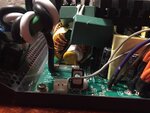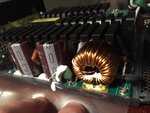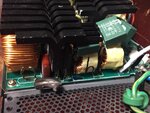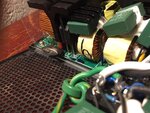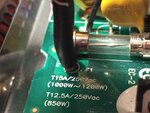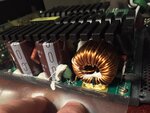lvshawnlv
Newbie level 6
Hello everyone. I am stumped and need help identifying a component inside this power supply. This is the 2nd psu I have gone through with this company and now this one has failed. The first one I originally purchased lasted less than 24 hours. This one made it almost 3 1/2 weeks before blowing the same exact component. I am hoping someone can point me in the right direction so that I'm able to purchase a new component (possibly maybe recommend one that is better than the one it's designed with) Luckily I have been keeping an eye on it for the past week so I was able to shut it down before it blew up. Once it started showing signs of visible exterior cracking and discolor in the center so I knew it was just a matter of time. Below is the specs, operating conditions, and devices that It's powering. Simply put I don't have the money to go out and buy a better one so any help to repair this one would be much appreciated. If you have a bitcoin address I would be more than happy to donate for some good leads. I know this power supply is still good as I caught it before it blew up.. The component basically turned to dust as I tried to wipe the surface to show some of the lettering leaving what u now see in the image.
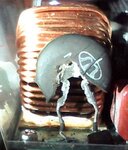
ROSEWILL 1200 PSU 80 PLUS GOLD
CAPSTONE G1200
115-240V 12-6A 60/50HZ
3.3 +5 +12 -12 +5VSB
25A 25A 100A 0.3A 3.5A
--150W-- 1200W 3.6W 17.5W
TOTAL 1200 -------------------------
line voltage 120.
2 WIRE NO GROUND (old structure) apt
using only the pci-e connectors on supply. 4x4 from psu to 2 6 pin per run. total 8 pci-e connectors (using only 6 out of 8).
each run is going to an ASIC miner. using 130w per blade x 6 at the wall and i switched out the stock fan for one that has higher airflow rate operating in 30F at night and 52 during daytime.
Any help would be much appreciated.. and thank you for your time =) and please direct me to where I can purchase another component if possible to upgrade the one It had in it to better quality, etc...
Shawn G
Las Vegas NV

ROSEWILL 1200 PSU 80 PLUS GOLD
CAPSTONE G1200
115-240V 12-6A 60/50HZ
3.3 +5 +12 -12 +5VSB
25A 25A 100A 0.3A 3.5A
--150W-- 1200W 3.6W 17.5W
TOTAL 1200 -------------------------
line voltage 120.
2 WIRE NO GROUND (old structure) apt
using only the pci-e connectors on supply. 4x4 from psu to 2 6 pin per run. total 8 pci-e connectors (using only 6 out of 8).
each run is going to an ASIC miner. using 130w per blade x 6 at the wall and i switched out the stock fan for one that has higher airflow rate operating in 30F at night and 52 during daytime.
Any help would be much appreciated.. and thank you for your time =) and please direct me to where I can purchase another component if possible to upgrade the one It had in it to better quality, etc...
Shawn G
Las Vegas NV
